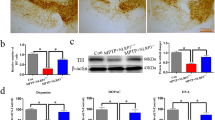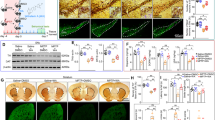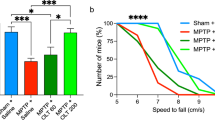Abstract
Endogenous neurotoxin 1-methyl-6,7-dihydroxy-1,2,3,4-tetrahydroiso-quinoline (Salsolinol, SAL) is a dopamine metabolite that is toxic to dopaminergic neurons in vitro and in vivo, and is involved in the pathogenesis of Parkinson’s disease (PD). However, the molecular mechanism by which SAL induces neurotoxicity in PD remains challenging for future investigations. This study found that SAL induced neurotoxicity in SH-SY5Y cells and mice. RNA sequencing (RNAseq) and Kyoto Encyclopedia of Genes and Genomes (KEGG) analysis were used to detect differentially expressed genes in SAL-treated SH-SY5Y cells. We found that NLR family pyrin domain-containing 3 (NLRP3)-dependent pyroptosis was enriched by SAL, which was validated by in vitro and in vivo SAL models. Further, NLRP3 inflammasome-related genes (ASC, NLRP3, active caspase 1, IL-1β, and IL-18) were increased at the mRNA and protein level. Acteoside mitigates SAL-induced neurotoxicity by inhibiting NLRP3 inflammasome-related pyroptosis in in vitro and in vivo PD models. In summary, the present study suggests for the first time that NLRP3-dependent pyroptosis plays a role in the pathogenesis of SAL-induced PD, and acteoside mitigates SAL-induced pyroptosis-dependent neurotoxicity in in vitro and in vivo PD models. The present results demonstrated a new mechanism whereby SAL mediates neurotoxicity by activating NLRP3-dependent pyroptosis, further highlighting SAL-induced pyroptosis-dependent neurotoxicity as a potential therapeutic target in PD.








Similar content being viewed by others
Data Availability
All data generated or analyzed during this study are included in this published article and its additional files.
References
Ahmed S, Panda SR, Kwatra M, Sahu BD, Naidu V (2022) Perillyl alcohol attenuates NLRP3 inflammasome activation and rescues dopaminergic neurons in experimental in vitro and in vivo models of Parkinson’s disease. ACS Chem Neurosci 13(1):53–68
Aimaiti M, Wumaier A, Aisa Y et al (2021) Acteoside exerts neuroprotection effects in the model of Parkinson’s disease via inducing autophagy: network pharmacology and experimental study. Eur J Pharmacol 903:174136
Alipieva K, Korkina L, Orhan IE, Georgiev MI (2014) Verbascoside—a review of its occurrence, (bio)synthesis and pharmacological significance. Biotechnol Adv 32(6):1065–1076
Antkiewicz-Michaluk L, Michaluk J, Romańska I, Papla I, Vetulani J (2000) Antidopaminergic effects of 1,2,3,4-tetrahydroisoquinoline and salsolinol. J Neural Transm (vienna) 107(8–9):1009–1019
Bollimuntha S, Ebadi M, Singh BB (2006) TRPC1 protects human SH-SY5Y cells against salsolinol-induced cytotoxicity by inhibiting apoptosis. Brain Res 1099(1):141–149
Briggs GD, Nagy GM, Dickson PW (2013) Mechanism of action of salsolinol on tyrosine hydroxylase. Neurochem Int 63(8):726–731
Brown D, Tamas A, Reglödi D, Tizabi Y (2013) PACAP protects against salsolinol-induced toxicity in dopaminergic SH-SY5Y cells: implication for Parkinson’s disease. J Mol Neurosci 50(3):600–607
Cai M, Zhuang W, Lv E et al (2022) Kaemperfol alleviates pyroptosis and microglia-mediated neuroinflammation in Parkinson’s disease via inhibiting p38MAPK/NF-κB signaling pathway. Neurochem Int 152:105221
Carlsson A, Lindqvist M, Magnusson T (1957) 3,4-Dihydroxyphenylalanine and 5-hydroxytryptophan as reserpine antagonists. Nature 180(4596):1200
Cookson MR (2009) alpha-Synuclein and neuronal cell death. Mol Neurodegener 4:9
Copeland RL, Das JR, Kanaan YM, Taylor RE, Tizabi Y (2007) Antiapoptotic effects of nicotine in its protection against salsolinol-induced cytotoxicity. Neurotox Res 12(1):61–69
Das JR, Tizabi Y (2009) Additive protective effects of donepezil and nicotine against salsolinol-induced cytotoxicity in SH-SY5Y cells. Neurotox Res 16(3):194–204
De Virgilio A, Greco A, Fabbrini G et al (2016) Parkinson’s disease: autoimmunity and neuroinflammation. Autoimmun Rev 15(10):1005–1011
Espay AJ, Brundin P, Lang AE (2017) Precision medicine for disease modification in Parkinson disease. Nat Rev Neurol 13(2):119–126
Fan Z, Liang Z, Yang H, Pan Y, Zheng Y, Wang X (2017) Tenuigenin protects dopaminergic neurons from inflammation via suppressing NLRP3 inflammasome activation in microglia. J Neuroinflammation 14(1):256
Getachew B, Csoka AB, Bhatti A, Copeland RL, Tizabi Y (2020) Butyrate protects against salsolinol-induced toxicity in SH-SY5Y cells: implication for Parkinson’s disease. Neurotox Res 38(3):596–602
Gonzalez G, Hodoň J, Kazakova A, D’Acunto CW, Kaňovský P, Urban M, Strnad M (2021) Novel pentacyclic triterpenes exhibiting strong neuroprotective activity in SH-SY5Y cells in salsolinol- and glutamate-induced neurodegeneration models. Eur J Med Chem 213:113168
Han C, Shen H, Yang Y et al (2020) Antrodia camphorata polysaccharide resists 6-OHDA-induced dopaminergic neuronal damage by inhibiting ROS-NLRP3 activation. Brain Behav 10(11):e01824
Han X, Sun S, Sun Y et al (2019) Small molecule-driven NLRP3 inflammation inhibition via interplay between ubiquitination and autophagy: implications for Parkinson disease. Autophagy 15(11):1860–1881
Heidari A, Yazdanpanah N, Rezaei N (2022) The role of Toll-like receptors and neuroinflammation in Parkinson’s disease. J Neuroinflammation 19:135
Huang S, Liu H, Lin Y et al (2020) Berberine protects against NLRP3 inflammasome via ameliorating autophagic impairment in MPTP-induced Parkinson’s disease model. Front Pharmacol 11:618787
Jung Y, Surh Y (2001) Oxidative DNA damage and cytotoxicity induced by copper-stimulated redox cycling of salsolinol, a neurotoxic tetrahydroisoquinoline alkaloid. Free Radic Biol Med 30(12):1407–1417
Jung YJ, Youn JY, Ryu JC, Surh YJ (2001) Salsolinol, a naturally occurring tetrahydroisoquinoline alkaloid, induces DNA damage and chromosomal aberrations in cultured Chinese hamster lung fibroblast cells. Mutat Res 474(1–2):25–33
Kim HJ, Soh Y, Jang JH, Lee JS, Oh YJ, Surh YJ (2001) Differential cell death induced by salsolinol with and without copper: possible role of reactive oxygen species. Mol Pharmacol 60(3):440–449
Kurnik-Łucka M, Panula P, Bugajski A, Gil K (2018) Salsolinol: an unintelligible and double-faced molecule-lessons learned from in vivo and in vitro experiments. Neurotox Res 33(2):485–514
Lee E, Hwang I, Park S et al (2019) MPTP-driven NLRP3 inflammasome activation in microglia plays a central role in dopaminergic neurodegeneration. Cell Death Differ 26(2):213–228
Lei H, Ren R, Sun Y et al (2020) Neuroprotective effects of safflower flavonoid extract in 6-hydroxydopamine-induced model of Parkinson’s disease may be related to its anti-inflammatory action. Molecules 25(21)
Li M, Zhou F, Xu T, Song H, Lu B (2018a) Acteoside protects against 6-OHDA-induced dopaminergic neuron damage via Nrf2-ARE signaling pathway. Food Chem Toxicol 119:6–13
Li T, Feng Y, Yang R et al (2018b) Salidroside promotes the pathological α-synuclein clearance through ubiquitin-proteasome system in SH-SY5Y cells. Front Pharmacol 9:377
Li W, Deng R, Jing X, Chen J, Yang D, Shen J (2020) Acteoside ameliorates experimental autoimmune encephalomyelitis through inhibiting peroxynitrite-mediated mitophagy activation. Free Radic Biol Med 146:79–91
Li Y, Xia Y, Yin S, Wan F, Hu J, Kou L, Sun Y, Wu J, Zhou Q, Huang J et al (2021) Targeting microglial α-synuclein/TLRs/NF-kappaB/NLRP3 inflammasome axis in Parkinson’s disease. Front Immunol 12:719807
Marogianni C, Sokratous M, Dardiotis E, Hadjigeorgiou GM, Bogdanos D, Xiromerisiou G (2020) Neurodegeneration and inflammation—an interesting interplay in Parkinson’s disease. Int J Mol Sci 21(22)
Martinez-Alvarado P, Dagnino-Subiabre A, Paris I et al (2001) Possible role of salsolinol quinone methide in the decrease of RCSN-3 cell survival. Biochem Biophys Res Commun 283(5):1069–1076
Matsuzawa S, Suzuki T, Misawa M (2000) Involvement of mu-opioid receptor in the salsolinol-associated place preference in rats exposed to conditioned fear stress. Alcohol Clin Exp Res 24(3):366–372
Mo Y, Xu E, Wei R et al (2018) Bushen-Yizhi formula alleviates neuroinflammation via inhibiting NLRP3 inflammasome activation in a mouse model of Parkinson’s disease. Evid Based Complement Alternat Med 2018:3571604
Naoi M, Maruyama W, Dostert P, Kohda K, Kaiya T (1996) A novel enzyme enantio-selectively synthesizes (R)salsolinol, a precursor of a dopaminergic neurotoxin, N-methyl(R)salsolinol. Neurosci Lett 212(3):183–186
Pajares M, Rojo IA, Manda G, Boscá L, Cuadrado A (2020) Inflammation in Parkinson’s disease: mechanisms and therapeutic implications. Cells 9(7)
Porter CC, Totaro JA, Stone CA (1963) Effect of 6-hydroxydopamine and some other compounds on the concentration of norepinephrine in the hearts of mice. J Pharmacol Exp Ther 140:308–316
Postuma RB, Berg D, Stern M, Poewe W, Olanow CW, Oertel W et al (2015) MDS clinical diagnostic criteria for Parkinson’s disease. Movement Disord 30:1591–1601. https://doi.org/10.1002/mds.26424
Qiu J, Chen Y, Zhuo J et al (2022) Urolithin A promotes mitophagy and suppresses NLRP3 inflammasome activation in lipopolysaccharide-induced BV2 microglial cells and MPTP-induced Parkinson’s disease model. Neuropharmacology 207:108963
Qualls Z, Brown D, Ramlochansingh C, Hurley LL, Tizabi Y (2014) Protective effects of curcumin against rotenone and salsolinol-induced toxicity: implications for Parkinson’s disease. Neurotox Res 25(1):81–89
Rui W, Li S, Xiao H, Xiao M, Shi J (2020) Baicalein attenuates neuroinflammation by inhibiting NLRP3/caspase-1/GSDMD pathway in MPTP induced mice model of Parkinson’s disease. Int J Neuropsychopharmacol 23(11):762–773
Shi J, Zhao Y, Wang K et al (2015) Cleavage of GSDMD by inflammatory caspases determines pyroptotic cell death. Nature 526(7575):660–665
Spillantini MG, Schmidt ML, Lee VM, Trojanowski JQ, Jakes R, Goedert M (1997) Alpha-synuclein in Lewy bodies. Nature 388(6645):839–840
Surh YJ, Jung YJ, Jang JH, Lee JS, Yoon HR (2002) Iron enhancement of oxidative DNA damage and neuronal cell death induced by salsolinol. J Toxicol Environ Health A 65(5–6):473–488
Tysnes OB, Storstein A (2017) Epidemiology of Parkinson’s disease. J Neural Transm (vienna) 124(8):901–905
Ungerstedt U (1968) 6-Hydroxy-dopamine induced degeneration of central monoamine neurons. Eur J Pharmacol 5(1):107–110
Vetulani J, Nalepa I, Antkiewicz-Michaluk L, Sansone M (2001) Opposite effect of simple tetrahydroisoquinolines on amphetamine- and morphine-stimulated locomotor activity in mice. J Neural Transm (Vienna) 108(5):513–526
Voon SM, Ng KY, Chye SM, Ling A, Voon K, Yap YJ, Koh RY (2020) The mechanism of action of salsolinol in brain: implications in Parkinson’s disease. CNS Neurol Disord Drug Targets 19:725–740
Wang F, Ni J, Wang X et al (2015) Salsolinol damaged neuroblastoma SH-SY5Y cells induce proliferation of human monocyte THP-1 cells through the mTOR pathway in a co-culture system. Neurochem Res 40(5):932–941
Wang H, Xu Y, Yan J et al (2009) Acteoside protects human neuroblastoma SH-SY5Y cells against beta-amyloid-induced cell injury. Brain Res 1283:139–147
Wang HQ, Sun XB, Xu YX, Zhao H, Zhu QY, Zhu CQ (2010) Astaxanthin upregulates heme oxygenase-1 expression through ERK1/2 pathway and its protective effect against beta-amyloid-induced cytotoxicity in SH-SY5Y cells. Brain Res 1360:159–167
Wang HQ, Xu YX, Zhu CQ (2012) Upregulation of heme oxygenase-1 by acteoside through ERK and PI3 K/Akt pathway confer neuroprotection against beta-amyloid-induced neurotoxicity. Neurotox Res 21(4):368–378
Wang K, Lu C, Wang T et al (2022) Hyperoside suppresses NLRP3 inflammasome in Parkinson’s disease via pituitary adenylate cyclase-activating polypeptide. Neurochem Int 152:105254
Wang S, Yuan YH, Chen NH, Wang HB (2019) The mechanisms of NLRP3 inflammasome/pyroptosis activation and their role in Parkinson’s disease. Int Immunopharmacol 67:458–464
Wang Y, Gao L, Chen J et al (2021) Pharmacological modulation of Nrf2/HO-1 signaling pathway as a therapeutic target of Parkinson’s disease. Front Pharmacol 12:757161
Wanpen S, Govitrapong P, Shavali S, Sangchot P, Ebadi M (2004) Salsolinol, a dopamine-derived tetrahydroisoquinoline, induces cell death by causing oxidative stress in dopaminergic SH-SY5Y cells, and the said effect is attenuated by metallothionein. Brain Res 1005(1–2):67–76
Wszelaki N, Melzig MF (2012) Low level of glutathione can intensify the toxic effect of salsolinol in SH-SY5Y neuroblastoma cell line. Neurotoxicology 33(3):424–428
Xia D, Zhang Z, Zhao Y (2018) Acteoside attenuates oxidative stress and neuronal apoptosis in rats with focal cerebral ischemia-reperfusion injury. Biol Pharm Bull 41(11):1645–1651
Xiao Y, Ren Q, Wu L (2022) The pharmacokinetic property and pharmacological activity of acteoside: a review. Biomed Pharmacother 153:113296
Yan YQ, Fang Y, Zheng R, Pu JL, Zhang BR (2020) NLRP3 inflammasomes in Parkinson’s disease and their regulation by Parkin. Neuroscience 446:323–334
Yasuda T, Nakata Y, Mochizuki H (2013) α-Synuclein and neuronal cell death. Mol Neurobiol 47(2):466–483
Yuan J, Ren J, Wang Y, He X, Zhao Y (2016) Acteoside binds to caspase-3 and exerts neuroprotection in the rotenone rat model of Parkinson’s disease. PLoS ONE 11(9):e0162696
Zhang M, He Q, Chen G, Li PA (2020) Suppression of NLRP3 inflammasome, pyroptosis, and cell death by NIM811 in rotenone-exposed cells as an in vitro model of Parkinson’s disease. Neurodegener Dis 20(2–3):73–83
Zheng R, Ruan Y, Yan Y et al (2021) Melatonin attenuates neuroinflammation by down-regulating NLRP3 inflammasome via a SIRT1-dependent pathway in MPTP-induced models of Parkinson’s disease. J Inflamm Res 14:3063–3075
Funding
This work was supported in part by the National Natural Science Foundation of China (81260196, 81450036), the Science Foundation of AMHT (2020YK02, 2021YK05), the Science Foundation of CASIC (2020-LCYL-009), the Science Foundation of ASCH (YN202104), the Hygiene and Health Development Scientific Research Fostering Plan of Haidian District Beijing (HP2021-19–50701), the Natural Science Foundation of Inner Mongolia Autonomous Region (IMAR) (2021MS08131, 2020MS08175, 2021LHMS08024, 2022MS08046), and the Foundation of Inner Mongolia Minzu University (NMGSS2128).
Author information
Authors and Affiliations
Contributions
YW, SW, and HW conceived of and designed the study, and HW provided administrative support. YW, SW, and HW wrote the manuscript. All authors analyzed and interpreted the data. All authors read and approved the final manuscript.
Corresponding authors
Ethics declarations
Ethics Approval and Consent to Participate
This study was carried out in accordance with the principles of the Basel Declaration and recommendations of Aerospace Center Hospital for laboratory animals. The animal study was reviewed and approved by medical ethics committee of Aerospace Center Hospital.
Consent for Publication
Not applicable.
Competing Interests
The authors declare no competing interests.
Additional information
Publisher's Note
Springer Nature remains neutral with regard to jurisdictional claims in published maps and institutional affiliations.
Supplementary Information
Below is the link to the electronic supplementary material.
Rights and permissions
Springer Nature or its licensor (e.g. a society or other partner) holds exclusive rights to this article under a publishing agreement with the author(s) or other rightsholder(s); author self-archiving of the accepted manuscript version of this article is solely governed by the terms of such publishing agreement and applicable law.
About this article
Cite this article
Wang, Y., Wu, S., Li, Q. et al. Salsolinol Induces Parkinson’s Disease Through Activating NLRP3-Dependent Pyroptosis and the Neuroprotective Effect of Acteoside. Neurotox Res 40, 1948–1962 (2022). https://doi.org/10.1007/s12640-022-00608-1
Received:
Revised:
Accepted:
Published:
Issue Date:
DOI: https://doi.org/10.1007/s12640-022-00608-1




